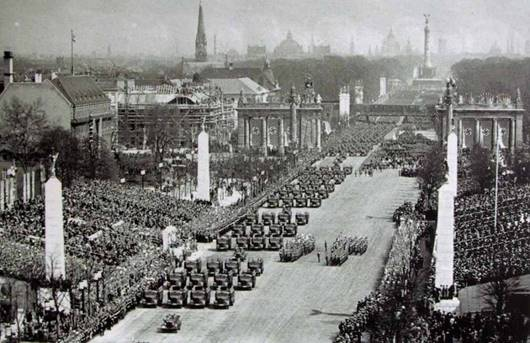Bribes worth millions. What was given to Hitler in honor of his anniversary
There has never been a case in the history of the world when the anniversary of its leader was celebrated so magnificently as it happened in Germany on April 20, 1939. Not only did the birthday become a national holiday, but they also prepared for it several years in advance. As a result, a large-scale military parade was organized, in which at least 50,000 soldiers and officers of the Luftwaffe, Kriegsmarine, Ground Forces, as well as SS units were involved. There were 20,000 honored guests in the stands, and over 2,000,000 spectators. The parade was accompanied by a demonstration of new military equipment, among which there were 162 aircraft that plied the skies of Berlin: Heinkel bombers and Messerschmitt fighters. Everyone was so eager to see the hero of the day that they regularly broke through the cordon of police, and some lost consciousness in the crowd. The festivities lasted for two days and were distinguished by their pathos, and with unprecedented pomposity, balancing on the verge of nausea.
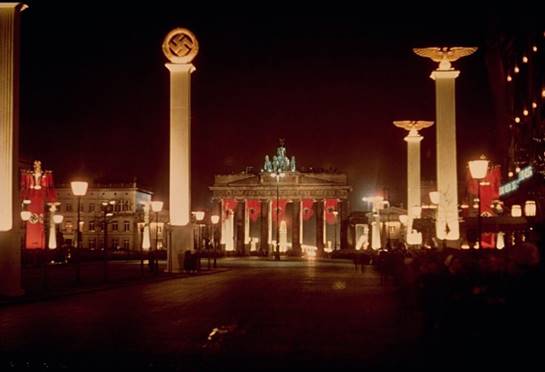
A colonnade with the symbols of the Third Reich and the Brandenburg Gate in the light of spotlights on the night of April 20, 1939. Photo: Hugo Jäger
Who will outdo whom. Competitions at the top of the party
Despite the fact that it was not until April 18, 1939, that the Reich Cabinet adopted a resolution to celebrate Hitler’s birthday as a national holiday, preparations for this celebration began at least a year and a half in advance. First of all, the Führer was impressed by his entourage, where Joseph Goebbels was the chief conductor. The keeper of the party treasury, Martin Bormann, knowing Hitler’s predilection for the Alpine beauties, hastened to order the architect Roderick Fick a tea house “Kehlsteinhaus”, better known as the “Eagle’s Nest” on the Kehlstein mountain, 1834 meters high, from where an amazing view of the Berchtesgaden Alps opened. The house itself is small, but its highlight was its location on a steep cliff, which could be climbed through a shaft lined with limestone slabs with a length of 124 meters, and from it a high-speed elevator ran to the top.
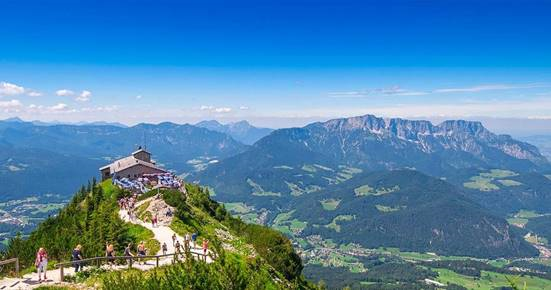
Small tea house “Kehlsteinhaus” (“Eagle’s Nest” at the suggestion of the American military). A gift from Martin Bormann. It is claimed that Hitler did not like this place because of the steep cliffs, but he was here 14 times. Photo source: https://www.kehlsteinhaus.de
Albert Speer did not want to lag behind Bormann and, in parallel with the construction of the New Reich Chancellery, was engaged in the arrangement of a wide avenue “West – East” in Berlin, which was conceived as a central highway through the future capital of the Reich “Germany”. Speer managed to get his gift and the grandiose celebration began with it. On the evening of April 19, Hitler, accompanied by a motorcade of 50 cars, inspected the West-East axis, on the sides of which powerful searchlights were installed, illuminating models of ancient temples, and arrived at the Brandenburg Gate, where Speer was already waiting for him with a report on the construction. Hitler liked the prospectus and, together with the architect, retired to the Reich Chancellery, from the balcony of which he watched the torchlight procession, while the whole city was immersed in the electric light of searchlights.
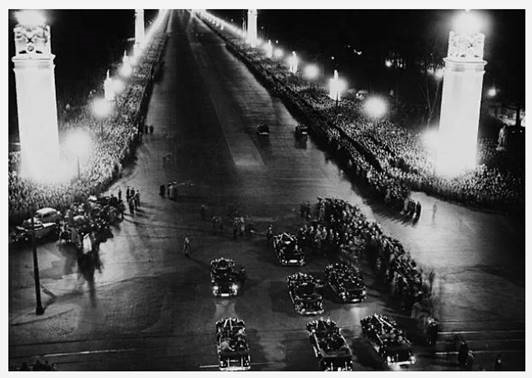
A rare shot. Preparation of Hitler’s motorcade for inspection of the wide avenue (axis) “West-East” on the eve of his birthday. April 19, 1939. Image source: “Berliner Illustrierte Zeitung”
The tables were full of gifts
However, Hitler was not allowed to retire to sleep, and on the night of April 19-20, they began to load him with gifts. First, Speer presented a four-meter model of the Arc de Triomphe, which was going to be erected in the new capital. Himmler presented him with a portrait of Frederick the Great of his own making. Goering, in addition to organizing an air parade, forked out for a model of the museum “House of German Art” made of solid gold.
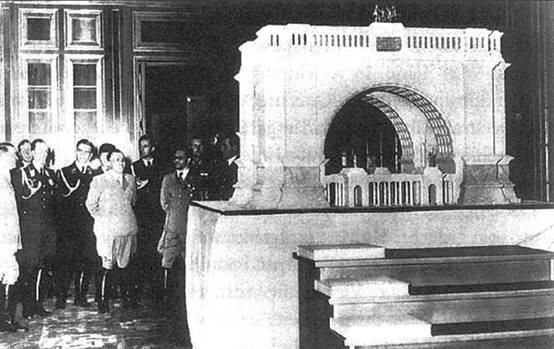
Another gift from Speer: a 4-meter model of the Arc de Triomphe for the future capital of Germany on the basis of Berlin.
Gifts were sent from different parts of Germany and the world, among which were marble figurines, tapestries, sculptures made of Meissen porcelain, original paintings by Titian, Lenbach, Waldmüller, medieval books. Tables were piled high with models of airplanes, ships, and submarines donated by German industrialists. According to the memoirs of Hitler’s private secretary, Gerda Christian, each of the guests tried to curry favor with the Führer by means of expensive, often tasteless gifts, the total value of which amounted to several million Reichsmarks. Ordinary Germans sent handicrafts in the form of blankets, pillows and products of their farms, so among the unprecedented luxuries there were trays with loaves, pies and baskets with chicken eggs. There were so many gifts that they were unloaded into the empty halls of the New Reich Chancellery.
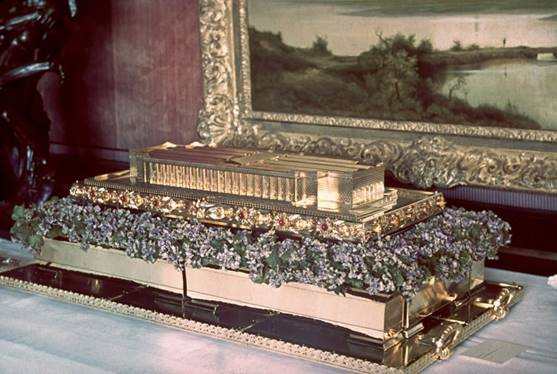
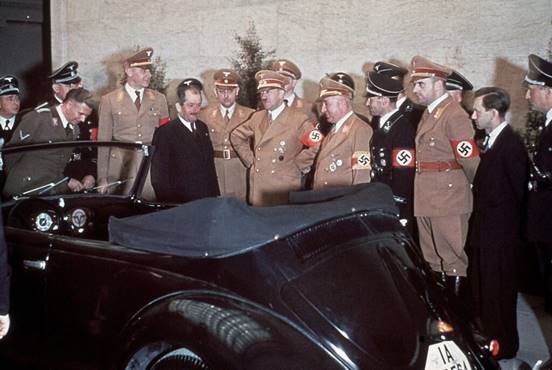
Ferdinand Porsche gave Hitler a Volkswagen convertible
Moved by the abundance of attention, the Reich Chancellor signed an order allocating budget funds in honor of his birthday to support children from low-income families, based on the amount of 15 Reichsmarks per child. A total of 13 million Reichsmarks were allocated.
Slogans, garlands and portraits on every corner
Already on the day of the publication of the government decree, the residents of Berlin, state institutions began to compete who would decorate the city better and more beautifully for the new national holiday. This led to the fact that portraits of Hitler, framed by flowers, began to appear on the windows of every private house, while trying to order a portrait larger than from a neighbor. But the winner turned out to be one of the Berlin publishing houses, which placed on its façade an eight-meter portrait of the Reich Chancellor with the pretentious slogan “Our loyalty is our gratitude!” Kilometers of garlands were stretched along the streets, and government buildings were simply hung with flags with swastikas, as a result of which the central part of the city became absolutely unrecognizable during the day, and at night, taking into account the work of searchlights, the streets of Berlin turned into a kind of sea of fire.
Police cordons could barely restrain the crowd of people who wanted to see the hero of the day closer. Photo: Heinrich Hoffmann
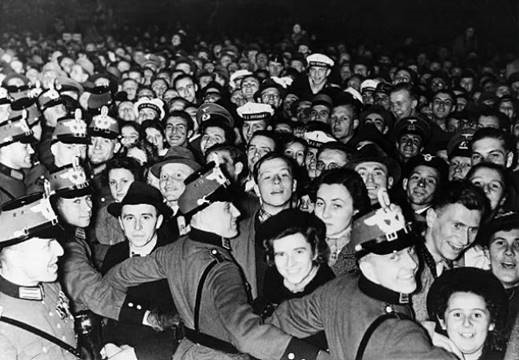
We send you a big hello
Not everyone was eager to fork out for gifts, even Mussolini limited himself to a congratulatory telegram. Actually, there were more telegrams and congratulatory letters, tangible gifts, although there was some embarrassment. For example, on the eve of the holidays, on April 14, U.S. President Franklin D. Roosevelt issued an ultimatum: either you give a guarantee that you will not attack 30 states friendly to the United States designated in a special list, or no congratulations. In Berlin, the ultimatum was ignored and no good wishes were received from Roosevelt, while British Prime Minister Neville Chamberlain and King George VI took the risk of congratulating the Munich deceiver. Remarkably, I could not find any mention of congratulations from Joseph Stalin.
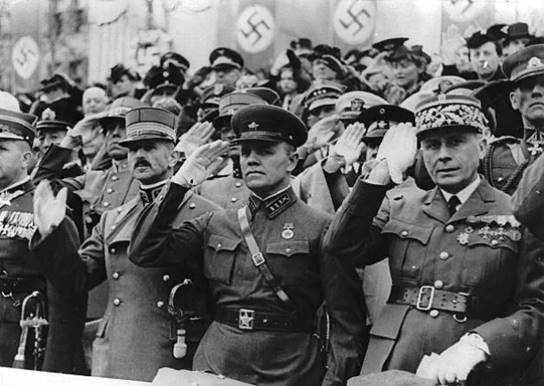
Assistant Military Attaché of the USSR in Germany A.V. Gerasimov is among the guests of honor at the military parade in honor of Hitler’s birthday on April 20, 1939.
The grand parade began on April 20, 1939. A special platform was organized for Hitler, on which a luxurious gilded armchair with velvet upholstery was installed. To the right of the chair was hoisted a personal standard, and behind it was an Imperial eagle surrounded by six banners. The opening of the parade began with an air show, followed by an infantry march.
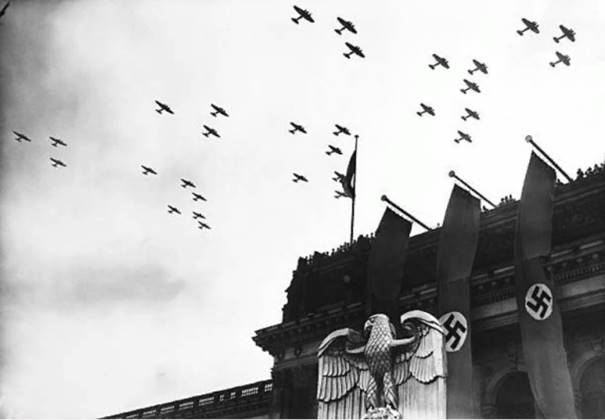
The parade began with a grand air show organized by Hermann Göring
This was followed by motorized and tank units, artillery, among which was the Kanone-3 heavy gun. But most of all, the audience was surprised by the presence of paratroopers, who for the first time in many years marched in a new uniform. In total, if you lined up all the soldiers who walked along with the equipment, you would get a chain about 90 kilometers long. The parade lasted 5 hours, at the end of which Hitler continued to meet with foreign delegations in the building of the Reich Chancellery, and guests and residents of the city walked until dawn.
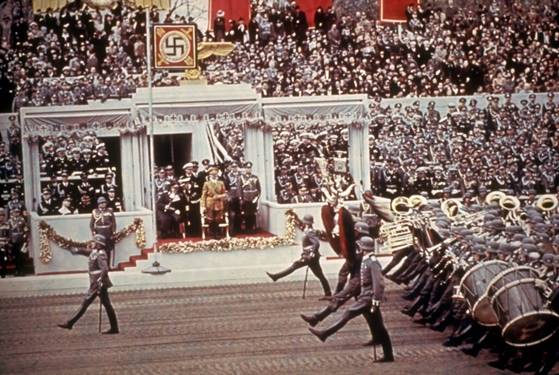
A platform with a gilded chair from where the hero of the day watched the parade
Findings. On the one hand, the organization of such an event was intended to surprise ordinary Germans, to stun them with its scale and at the same time to unite, make them pliant and devoted. Researchers, based on the memoirs of Hitler’s personal valet Heinz Linge, claim that the organization of such an event was a balm for the soul of the inhibited Führer. And thirdly, the party leadership laid the foundations for the depersonalization of Hitler, making the figure of the Führer sacred, but not the person who held this post, and this in the future could lead to free replacement by another, more accommodating candidate.
